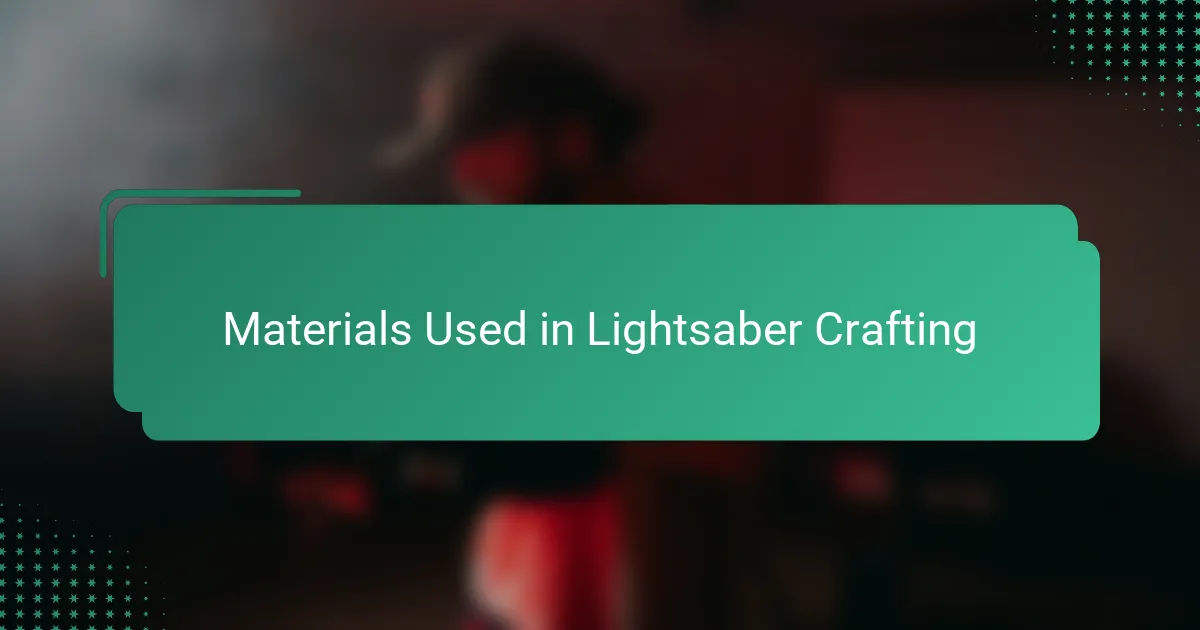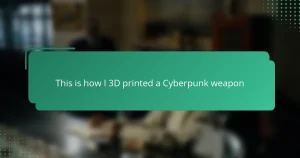Key takeaways
- Science fiction props are crafted with attention to detail, blending art and engineering to create emotional connections with audiences.
- Essential tools and materials, like aluminum for the hilt and polycarbonate for the blade, are crucial for achieving authenticity in prop making.
- Adding special effects, including sound and lighting, enhances the storytelling aspect, making props feel alive and immersive.
- Regular maintenance and solid construction practices extend the lifespan and durability of props, ensuring they remain cherished items.

Understanding Science Fiction Props
Science fiction props aren’t just ordinary objects; they carry stories and evoke emotions. I’ve felt this deeply when holding a well-crafted prop—there’s an almost magical connection between imagination and reality. Have you ever wondered how a simple piece of plastic can make you feel like you’re part of an epic universe?
From my experience, understanding these props means appreciating their design, materials, and purpose. It’s fascinating how each detail, no matter how small, contributes to the believability of the story. What makes a lightsaber more than just a glowing stick? It’s the craftsmanship behind it that sparks wonder.
Sometimes, I think about the dedication prop makers pour into their work. They blend art, engineering, and storytelling in ways that truly inspire. Isn’t it amazing how these props become icons that fans cherish for decades? That emotional bond is what makes science fiction props so unique.

Essential Tools for Prop Making
When I first dove into prop making, the sheer variety of tools felt overwhelming. But over time, I realized that a sturdy cutting mat, precision knives, and a quality soldering iron became my closest allies. Why? Because these essentials allowed me to shape and assemble parts with care, turning abstract ideas into tangible pieces.
I remember the excitement of holding my first 3D printer output—it’s amazing how technology can elevate craftsmanship. Yet, no matter how advanced, nothing replaces simple tools like fine files and clamps for those delicate finishing touches. Have you ever noticed how the smallest imperfections can make or break the illusion? That’s where these trusty tools proved their worth.
In my experience, having an organized workspace filled with reliable tools fuels creativity. It’s not just about having everything at hand, but about knowing which tool to pick to bring a vision to life efficiently. Wouldn’t you agree that the right tools don’t just make the process easier—they make it more joyful?

Materials Used in Lightsaber Crafting
Choosing the right materials was crucial in crafting my lightsaber. I leaned heavily on aluminum tubing for the hilt—it’s lightweight yet sturdy, giving the prop an authentic heft without being cumbersome. Have you ever held something that felt solid and real, yet didn’t weigh down your hand? That balance is exactly what aluminum delivers.
To mimic the glowing blade, I experimented with polycarbonate rods, opting for their durability and clarity. These rods diffuse light beautifully, creating that iconic radiant glow. I remember the first time I illuminated the blade and saw the soft, even glow—it felt like magic come to life. Isn’t it satisfying when materials behave exactly as you envision?
For the electronic components, I used high-lumen LEDs along with rechargeable lithium-ion batteries. Integrating these gave the lightsaber not just light, but a convincing, consistent brightness. Figuring out how to wire everything seamlessly was a challenge, but the payoff made every late-night soldering session worth it. Have you ever experienced that moment when your creation truly comes alive? That’s the thrill I chase every time.

Step by Step Lightsaber Assembly
Starting the assembly, I carefully fitted the aluminum hilt sections together, feeling that satisfying click as each piece locked into place. It’s incredible how precise alignment can make or break the whole structure—have you ever found yourself tweaking a part repeatedly just to get that perfect fit? That moment when everything slots seamlessly feels almost like the prop is coming alive in your hands.
Next, I threaded the wiring through the hilt to connect the LED module and battery pack. Navigating those tight spaces was a test of patience, but watching the circuits light up for the first time made every pinch and fumble worth it. Isn’t there something profoundly rewarding about breathing life into something that started off as mere metal and plastic?
Finally, attaching the polycarbonate blade brought everything together—glowing with a soft, even light that instantly transported me into a galaxy far, far away. The balance between the hilt’s weight and the blade’s glow was crucial, and holding it felt like wielding a piece of my imagination. Have you ever held a prop that made you forget the real world for just a moment? That’s exactly the magic I chase with each assembly step.

Adding Special Effects
Adding special effects was where the lightsaber truly began to transcend mere craft and enter the realm of storytelling. I remember the thrill of installing LED strips and experimenting with different diffuser materials to achieve that perfect, otherworldly glow. Have you ever adjusted a light source for hours, chasing that elusive balance between brightness and softness? It’s surprisingly addictive.
Sound effects added another layer of immersion. I incorporated small speakers with custom soundboards, which brought the blade’s hum and clash to life. There’s something deeply satisfying about hearing your creation react to movement, like it has a heartbeat of its own. Don’t you think that sound is what makes a prop feel less like an object and more like a character?
Finally, I played with subtle flickering and pulse effects, mimicking the unpredictable energy one expects from a real lightsaber. Achieving this took more trial and error than I anticipated, but the payoff was worth every frustrating moment. When the blade glowed and pulsed in sync with the sounds, it felt like my creation was alive in a galaxy far beyond my workshop. Have you ever felt that kind of magic in your projects?

Personal Tips for Prop Durability
Durability quickly became a top priority as I crafted my lightsaber. Reinforcing stress points—like the blade attachment and internal wiring—helped prevent those frustrating moments when a prop suddenly fails mid-use. Have you ever had a favorite prop break just when you wanted to show it off? That stings, and it’s why I obsess over solid construction.
Choosing the right adhesives played a bigger role than I expected. I experimented with different glues, settling on ones that bonded metal and plastic firmly without becoming brittle over time. It’s funny how such a small decision can affect a prop’s lifespan so much, but every crack avoided felt like a victory.
Finally, I made a habit of regular checks and gentle maintenance. Cleaning contacts, tightening screws, and carefully storing the lightsaber after use prolonged its life dramatically in my experience. Have you noticed how a little care can keep your cherished items looking and feeling like new? For me, that ongoing attention makes all the difference.

Showcasing the Finished Lightsaber
Showcasing the finished lightsaber was a moment filled with pride and a bit of awe. Holding it up, I could see how every painstaking detail—from the polished aluminum hilt to the softly glowing blade—came together to create something truly captivating. Have you ever experienced that rush when a project finally looks and feels exactly like you imagined?
Displaying it wasn’t just about showing off the craft; it was about sharing a piece of the story I’d poured myself into. The subtle hum from the LEDs and the balanced weight made it feel alive in my hands, almost inviting others to believe in that distant galaxy for a moment. Isn’t it incredible how a prop can spark imagination and connection beyond its physical form?
Sometimes, I set it against different backdrops, watching how light and shadow played across its surfaces. That interplay brought out nuances I hadn’t noticed before, reminding me that a finished prop is a living artwork that changes with perspective. Have you ever found new inspiration just by seeing your creation in a new light?


